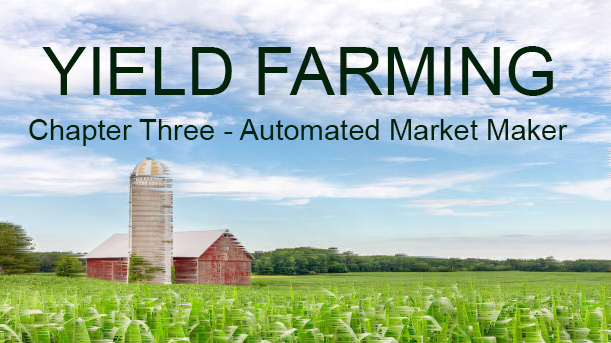Yield Farming Chapter Three - Automated Market Maker

This is Chapter Three, focused on Automated Market Maker, in a series of articles that will be released about yield farming. The purpose of this series is to introduce the concept of yield farming to those who are unfamiliar with it, then move into various yield farming strategies and finally step-by-step walkthrough of the process. I hope you enjoy the series and any feedback you have would be greatly appreciated.
Chapter Three - Automated Market Maker
Automated (adjective) an automated factory, office, or process uses machines to do the work instead of people
Market (noun) an area or arena in which commercial dealings are conducted
Maker (noun) a person or thing that makes or produces something
An Automated Marker Maker (AMM) is the protocol that allows a decentralized exchange (DEX) by allowing cryptocurrencies or other assets to be traded using liquidity pools (LPs) for automated liquidity.
What is an Automated Market Maker?
In a traditional financial market transaction they use an order matching system of connecting buyers and sellers based on the prices each set to come up with a match. This happens with stocks, commodities, real estate and virtually all other traditional assets. In cryptocurrency, centralized exchanges work in a similar fashion as traditional financial markets. In decentralized finance (DeFi), they have come up with a much more efficient system of continual liquidity held in an automated money maker (AMM). Within the AMM, a liquidity pool holds a large amount of tokens in an equal value (50/50) so users can swap one of those tokens for another quickly and efficiently.
These digital asset transactions happen in a permissionless manner and happen automatically within the liquidity pool. The DEX allows for autonomy giving users the authority to make trades or swaps straight from non-custodial wallets in which the user controls his or her own private keys. The AMM protocols use smart contracts, self-executing computer code, to determine the price of the digital assets in question and provide liquidity. These smart contracts are the liquidity pools allowing for the swaps between tokens to take place.
Automated Market Maker Mathematical Formula
The beauty of an AMM all began with this simple formula first proposed by Ethereum founder Vitalik Buterin in a blog post regarding “on-chain market makers.” The formula is as follows:
tokenA_balance(p) * tokenB_balance(p) = k
In this formula "k" represents a constant balance of assets that determines the price of LP tokens in a liquidity pool. Since "k" cannot change, the change in price of the underlying assets in a LP token requires a rebalancing of the underlying pair of coins to maintain this balance.
This formula has since been simplified to "X * Y" = k in which X represents the balance of one token and Y represents the balance of the other token.
How do prices in an Automated Market Makers Work?
Cryptocurrencies in a liquidity pool locked in an automated market maker use the algorithm above to determine the price of each cryptocurrency based on the amount of liquidity each has in the pool. Like all of economics, it is a simple supply and demand function that ultimately drives the price action of the underlying assets in a liquidity pool.
As an example, if you have Bitcoin (BTC) and Tether (USDT) in a liquidity pool, when large amounts of Bitcoin swaps are taking place the price of BTC goes up since less BTC exist in the liquidity pool and more USDT is now present. In the liquidity pool, the AMM will need to adjust by raising the price of BTC and to compensate for holding more USDT (a stablecoin that theoretically retains a $1 price) in relation to BTC to retain the balance of the two underlying coins.
The larger the liquidity, or total value locked within a liquidity pool, the more stable the prices of the underlying two tokens will remain. In-other-words, transactions within the AMM will have a smaller impact on the total liquidity because the transaction has a smaller impact on the algorithm keeping the two tokens in balance.
Whiteboard Crypto YouTube Video - What is an Automated Market Maker
Previous Chapters